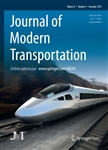Speed–density functional relationship for heterogeneous traffic data: a statistical and theoretical investigation
Speed–density functional relationship for heterogeneous traffic data: a statistical and theoretical investigation作者机构:Department of Civil Engineering Indian Institute of Technology
出 版 物:《Journal of Modern Transportation》 (现代交通学报(英文版))
年 卷 期:2019年第27卷第1期
页 面:61-74页
学科分类:1201[管理学-管理科学与工程(可授管理学、工学学位)] 0808[工学-电气工程] 0809[工学-电子科学与技术(可授工学、理学学位)] 08[工学] 0802[工学-机械工程] 0814[工学-土木工程] 0801[工学-力学(可授工学、理学学位)] 0823[工学-交通运输工程] 0812[工学-计算机科学与技术(可授工学、理学学位)]
主 题:Heterogeneous traffic Speed-density model Kinematic wave speed Traffic flow CURE plots
摘 要:This study is an attempt to establish a suitable speed–density functional relationship for heterogeneous traffic on urban arterials. The model must reproduce the traffic behaviour on traffic stream and satisfy all static and dynamic properties of speed–flow–density relationships. As a first attempt for Indian traffic condition, two behavioural parameters, namely the kinematic wave speed at jam(Cj) and a proposed saturation flow(k), are estimated using empirical observations. The parameter Cjis estimated by developing a relationship between driver reaction time and vehicle position in the queue at the signalised intersection. Functional parameters are estimated using Levenberg–Marquardt algorithm implemented in the R statistical *** measures such as root mean squared error, average relative error and cumulative residual plots are used for assessing models fitness. We set out several static and dynamic properties of the flow–speed–density relationships to evaluate the models, and these properties equally hold good for both homogenous and heterogeneous traffic *** the numerical analysis, it is found that very few models replicate empirical speed–density data traffic ***, none of the existing functional forms satisfy all the properties. To overcome the shortcomings, we proposed two new speed–density functional forms. The uniqueness of these models is that they satisfy both numerical accuracy and the properties of fundamental diagram. These new forms would certainly improve the modelling accuracy, especially in dynamic traffic studies when coupling with dynamic speed equations.



